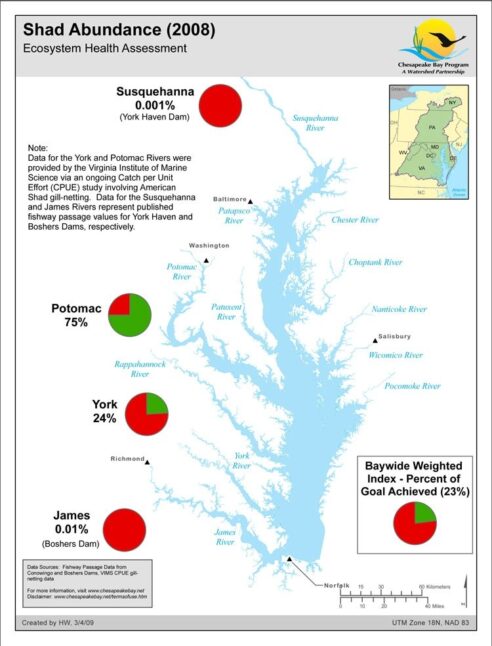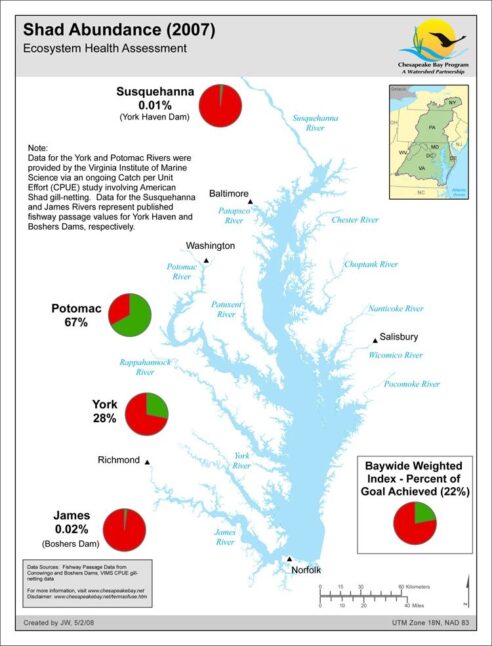Maps
Browse through maps depicting Bay health and restoration, including pollution trends, public access sites and more.
Shad Abundance (2015)
Date created: May 16, 2016American shad were once the most abundant and economically important species in the Chesapeake Bay. Shad are anadromous fish and spend most of their lives in the ocean, returning to freshwater rivers to spawn after they reach maturity. Data for the York, Potomac, Rappahannock and lower James Rivers were provided by the Virginia Institute of Marine Science via an ongoing Catch per Unit Effort (CPUE) study involving American Shad gill-netting. Data for the Susquehanna and upper James Rivers represent published fishway passage values for Conowingo and Boshers Dams, respectively.
View mapShad Abundance (2014)
Date created: March 25, 2015American shad were once the most abundant and economically important species in the Chesapeake Bay. Shad are anadromous fish and spend most of their lives in the ocean, returning to freshwater rivers to spawn after they reach maturity. Data for the York, Potomac, Rappahannock and lower James Rivers were provided by the Virginia Institute of Marine Science via an ongoing Catch per Unit Effort (CPUE) study involving American Shad gill-netting. Data for the Susquehanna and upper James Rivers represent published fishway passage values for Conowingo and Boshers Dams, respectively.
View mapShad Abundance (2013)
Date created: March 24, 2014American shad were once the most abundant and economically important species in the Chesapeake Bay. Shad are anadromous fish and spend most of their lives in the ocean, returning to freshwater rivers to spawn after they reach maturity. Data for the York, Potomac, Rappahannock and lower James Rivers were provided by the Virginia Institute of Marine Science via an ongoing Catch per Unit Effort (CPUE) study involving American Shad gill-netting. Data for the Susquehanna and upper James Rivers represent published fishway passage values for Conowingo and Boshers Dams, respectively.
View mapShad Abundance (2012)
Date created: October 24, 2013American shad were once the most abundant and economically important species in the Chesapeake Bay. Shad are anadromous fish and spend most of their lives in the ocean, returning to freshwater rivers to spawn after they reach maturity. Data for the York, Potomac, Rappahannock and lower James Rivers were provided by the Virginia Institute of Marine Science via an ongoing Catch per Unit Effort (CPUE) study involving American Shad gill-netting. Data for the Susquehanna and upper James Rivers represent published fishway passage values for Conowingo and Boshers Dams, respectively.
View mapShad Abundance (2010)
Date created: March 29, 2011American shad were once the most abundant and economically important species in the Chesapeake Bay. Shad are anadromous fish and spend most of their lives in the ocean, returning to freshwater rivers to spawn after they reach maturity. Data for the York and Potomac Rivers were provided by the Virginia Institute of Marine Science via an ongoing Catch per Unit Effort (CPUE) study involving American Shad gill-netting. Data for the Susquehanna and James Rivers represent published fishway passage values for Conowingo and Boshers Dams, respectively.
View mapShad Abundance (2009)
Date created: March 8, 2010American shad were once the most abundant and economically important species in the Chesapeake Bay. Shad are anadromous fish and spend most of their lives in the ocean, returning to freshwater rivers to spawn after they reach maturity. Data for the York and Potomac Rivers were provided by the Virginia Institute of Marine Science via an ongoing Catch per Unit Effort (CPUE) study involving American Shad gill-netting. Data for the Susquehanna and James Rivers represent published fishway passage values for Conowingo and Boshers Dams, respectively.
View mapShad Abundance (2008)
Date created: March 4, 2009American shad were once the most abundant and economically important species in the Chesapeake Bay. Shad are anadromous fish and spend most of their lives in the ocean, returning to freshwater rivers to spawn after they reach maturity. Data for the York and Potomac Rivers were provided by the Virginia Institute of Marine Science via an ongoing Catch per Unit Effort (CPUE) study involving American Shad gill-netting. Data for the Susquehanna and James Rivers represent published fishway passage values for Conowingo and Boshers Dams, respectively.
View map
Shad Abundance (2007)
Date created: May 2, 2008American shad were once the most abundant and economically important species in the Chesapeake Bay. Shad are anadromous fish and spend most of their lives in the ocean, returning to freshwater rivers to spawn after they reach maturity. Data for the York and Potomac Rivers were provided by the Virginia Institute of Marine Science via an ongoing Catch per Unit Effort (CPUE) study involving American Shad gill-netting. Data for the Susquehanna and James Rivers represent published fishway passage values for Conowingo and Boshers Dams, respectively.
View map
